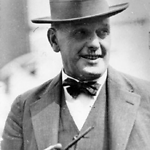Person
Arnot, Arthur James (1865 - 1946)

Arthur James Arnot
Details
- Born
- 26 August 1865
Hamilton, Scotland - Died
- 15 October 1946
Castle Hill, New South Wales, Australia - Occupation
- Electrical engineer
Summary
Arthur Arnot was the first electrical engineer of the Melbourne city council, appointed in 1891. He designed and managed the Spencer Street power station and was Australasian manager of Babcock & Wilcox Ltd, Sydney 1901-1929.
Details
Educated Hutchisontown Grammar School and Haldane Academy, Glasgow. Entered Glasgow College of Science 1881. Appointed assistant engineer Grosvenor Gallery power station. Arrived Melbourne 1889 under two year contract to erect a large alternating-current plant for Union Electric Co. City Electrical Engineer 1891-1901. Patented the world's first electric drill on 20 August 1889. Installed comprehensive system of street lighting in Melbourne city 1891-92. designed and managed Spencer Street power station 1894-1901. Helped draft the Victorian Electric Light and Power Act of 1896. Member, Institution of Electrical Engineers, London 1899-1906. President, Electrical Association of New South Wales. President, Victorian Institute of Electrical Engineers 1899. Examiner in electrical technology for Victorian technical schools. Councillor, Working Men's College 1897-1901. Australasian manager, Babcock & Wilcox Ltd, Sydney 1901-29. Lieutenant, Submarine Company, Victorian Engineers from 1894 and served with Australian Engineers, Australian Military Forces from 1915. Retired in 1925 with rank of major. Retired from Babcock & Wilcox Ltd 1929.
Chronology
- 1 Dec 1891
- Career event - Associate Member (AssocMInstCE), Institution of Civil Engineers, London
- 1902
- Career event - Member, Electrical Association of New South Wales
- 1908 - 1909
- Career position - President, Electrical Association of New South Wales
- 12 Apr 1910
- Career event - Member (MInstCE), Institution of Civil Engineers, London
Related entries
Children
Published resources
Book Sections
- Goss, Noel; O'Neill, Sally, 'Arnot, Arthur James (1865-1946), Electrical Engineer' in Australian dictionary of biography, volume 7: 1877 - 1850 I-Z, Bede Nairn and Geoffrey Serle, eds (Melbourne: Melbourne University Press, 1979), pp. 100-101. http://www.adb.online.anu.edu.au/biogs/A070103b.htm. Details
Journal Articles
- Arnot, Arthur James, 'Some notes on the electric lighting of the City of Melbourne (Paper & Discussion)', Various Papers and Discussions of the Victorian Institute of Engineers vol. II 1892-1899 (1900). http://hdl.handle.net/11343/24239. Details
Newspaper Articles
- 'Coming Men. No. 13 - Mr A. J. Arnot', Table Talk (1893), 4, http://nla.gov.au/nla.news-article145711217. Details
Resources
- Wikidata, http://www.wikidata.org/entity/Q4799222. Details
- Institution of Civil Engineers, London, 'Application: 7893, 1891', Civil Engineer Membership Forms, 1818-1930, ancestry.com, https://www.ancestry.com.au/search/collections/3585/. Details
- 'Arnot, Arthur James (1865-1946)', Trove, National Library of Australia, 2009, https://nla.gov.au/nla.party-1467361. Details
Resource Sections
- 'Imaginative Innovations, Electric Drill (1889)', in Tomorrow's World: The Australian Initiative, 1999?, http://www.apc-online.com/twa/history6.html. Details
See also
- Smith, James, ed., The Cyclopedia of Victoria: an historical and commercial review: descriptive and biographical, facts, figures and illustrations: an epitome of progress (Melbourne: Cyclopedia Co, 1903-1905), vol.1: 618 pp, vol.2: 563 pp, vol.3: 643 pp. 'Arthur James Arnot' Vol.1 p.321. Details
- Stewart, Don, 'Chapter 10: The heavy engineering industry and engineering products' in Sydney: from settlement to city: an engineering history of Sydney, Don Fraser, ed. (Crows Nest, New South Wales: Engineers Australia, 1989), pp. 201-218. Details
Digital resources
Helen Morgan
Created: 31 October 2000, Last modified: 8 February 2023
